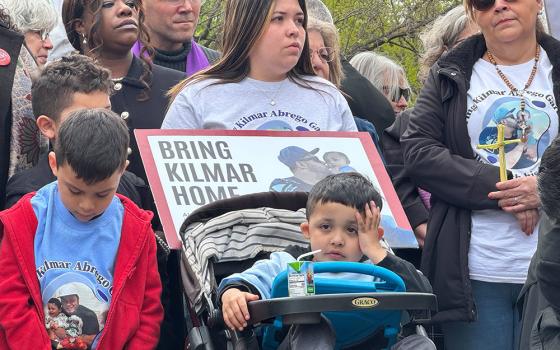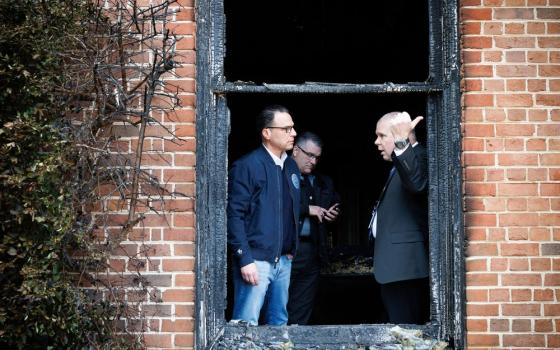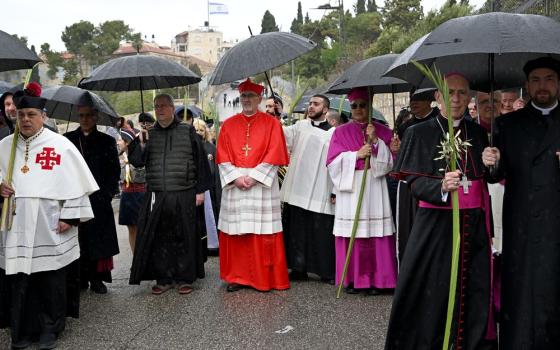
All our religious traditions agree that animals must be treated humanely and their suffering minimized. All our traditions agree as well that human workers must be treated fairly, justly and humanely.
One out of every six people in the world works to provide the food we eat -- in the fields and in food processing and transport, in restaurants, and in food stores. We affirm their right to decent incomes, working conditions, and to organize themselves.
Eating is thus a moral act.
In particular, the way we humans treat animals has moral significance. In theological words used by the late Pope John Paul II, the institutionalized and industrialized mode of treating animals that ignores their being creatures of God can be considered “a structure of sin.”
The bishops of Ohio last year published a statement in support of industrialized animal production in that state -- specifically in support of Confined Animal Feeding Operations (CAFOs) -- and recommended that Ohioans vote yes in last November’s state election for Referendum Issue 2, which created the Ohio Livestock Care Standards Board animal welfare committee. The Humane Society of America described this measure as an empty one, devised by the state’s agribusinesses to block real reform of factory farming of animals.
The bishops stated that their recommendation involved a prudential judgment on which people of goodwill can differ. I argue that the overwhelming weight of Catholic thinking suggests that to vote no on that issue was more appropriate.
The research staff of the Ohio bishops had not done its homework on the issue of CAFOs. These factory farms are part of a culture of abuse, not a culture of life. The operators, workers, the environment and the animals are all abused. The problem is not just that of specific farms or the good intention of operators, the problem is the entire system: It is not sustainable. An adequate definition of sustainability includes the way the animals are treated.
Ohio experts on agriculture, such as rural sociologist Linda Lobao of Ohio State University, have written eloquently about these animal factory farms. Her conclusion is that they hurt communities and animals significantly.
There is Catholic literature on the subject as well.
In 1998, the National Catholic Rural Life Conference, the leading national Catholic voice on rural life since 1923, called for a moratorium on CAFO construction. In 1999, Chicago Cardinal Francis George said that CAFOs are not family farms, but factories. “At some point in time we crossed the line and some of these facilities became factories, not farms as we once knew them,” he said.
The contract labor that is involved in the CAFO system is morally suspect.
Those who manage these so-called confined animal feeding operations are appropriately called “operators.” The operators do not have freedom of choice in their management practices, which is why contracts have been criticized as unjust and why the U.S. Catholic bishops, as well as the Rural Life Conference, have worked with broad coalitions for contract reform as part of their advocacy.
The workers on these operations are frequently in unhealthy environments filled with dust and ammonia and other pathogens. Workers are subject to ongoing respiratory problems.
These matters have been raised by the American Public Health Association, the American Medical Association, and other similar organizations. They have also identified the serious issue of the recurrent use of antibiotics meant for human use in animal feed. The use of antibiotics in this fashion endangers human health and puts the health of future generations at risk with the loss of effective antibiotics.
CAFOs abuse the environment. This is recognized by the U.S. bishops in “For I Was Hungry and You Gave Me Food,” in which they wrote, “Catholic teaching about the stewardship of creation leads us to question certain farming practices, such as the operation of massive confined animal feeding operations.” As a member of the team that worked on this document, I know the intent was serious: to protect the environment from abuse.
Now we know that such operations add significantly to climate change. According to the United Nations’ study “Livestock’s Long Shadow,” almost a third of climate-changing gases can be attributed to the way we raise livestock.
In addition to the abuse of operators, workers, and the environment, central to the Catholic criticism of CAFOs is their abuse of the animals.
When asked about cruelty to animals in a 2002 interview, the current pope, Benedict XVI, said, “That is a very serious question. At any rate, we can see that they are given into our care, that we cannot just do whatever we want with them. Animals, too, are God’s creatures. ... Certainly, a sort of industrial use of creatures, so that geese are fed in such a way as to produce as large a liver as possible, or hens live so packed together that they become just caricatures of birds, this degrading of living creatures to a commodity seems to me in fact to contradict the relationship of mutuality that comes across in the Bible.”
Then-Cardinal Joseph Ratzinger was echoing official church teachings laid out in the catechism, which states clearly, “Animals are God’s creatures. He surrounds them with his providential care. By their mere existence they bless him and give him glory. Thus men owe them kindness. We should recall the gentleness with which saints like St. Francis of Assisi or St. Philip Neri treated animals. ... It is contrary to human dignity to cause animals to suffer or die needlessly.”
In December 2000, Marie Hendrickx, a longtime official of the Congregation for the Doctrine of the Faith, wrote about animal welfare in the Vatican newspaper, L’Osservatore Romano, raising the following questions: “Does the right to use animals for food imply the right to raise chickens in tiny cages where they live in a space smaller than a notebook? Or calves in compartments where they can never move about or see the light? Or to keep sows pinned by iron rings in a feeding position to allow a series of piglets to suck milk constantly and thus grow faster? Does the right to use animals for clothing mean letting those with valuable pelts slowly die of hunger, thirst, cold or hemorrhage in traps? Does the right to use animals for our leisure mean the right to stab bulls with bandilleras after tormenting them at length? Does it mean letting horses be disemboweled? Does it mean throwing cats or goats from the top of bell towers?”
Her questioning concludes that the answer to each question is a strong no.
I grew up in rural Massachusetts living close to animals. I helped feed and raise chickens for their eggs and meat. During my novitiate with the Holy Cross brothers, I worked closely with pigs and cattle. I learned how to slaughter and skin steers. I have looked food animals in the eyes and learned a certain sense of spiritual concern as I cared for animals before they were consumed.
There is a living sense of dying and rising, of the paschal mystery, in food animal farming. There comes an appreciation of animals as sentient beings. The distancing that accompanies mass production removes that sensitivity from human interaction. A focus on efficiency leads to desensitization. Violence replaces care. Suffering becomes justified on the basis of economic necessity. This becomes a fact of life, seldom acknowledged.
As a member of the Pew Commission on Industrial Farm Animal Production for two years, I visited CAFOs for pigs, cattle, chickens and dairy cows. I went to facilities operated by companies such as Cargill in Minnesota, Smithfield in North Carolina, Tyson in Arkansas, and dairy farms in California. I was selected for the commission because I have a long history of working to support rural communities, animal welfare, family farmers and a healthy environment.
On these trips I was confronted with the ways these animals are raised and treated. Chickens were raised in small wire cages so that they had no room to turn around and were packed together, usually eight in one cage, with no space for normal animal behavior. They were denied, for example, the capacity to spread their wings.
Cattle on a feedlot in Colorado were densely packed, up to several hundred, in one common space, often standing for days in their own feces. Mother pigs were held down and in place by metal bands, unable to walk or stand, in order that the piglets could have full access to the mothers’ milk in devices called gestation crates.
All of these ways of treating animals cause them obvious suffering. These industrial methods of meat production imitate the assembly line modes of production of automobile. Food animals in these systems are raised using methods that intrinsically hurt them. This is called efficient, but it is actually a culture of death, contrary to a culture of life.
If one is going to be fully pro-life, one needs to be pro-animal.
[Holy Cross Br. David Andrews is a senior representative for Food and Water Watch in Washington. He is former director of the National Catholic Rural Life Conference.]
| Special Coverage for the National March for Life
To mark the 37th annual March for Life in Washington, NCR has prepared a series of articles that will appear on our Web site Jan. 21 and Jan. 22.
|



